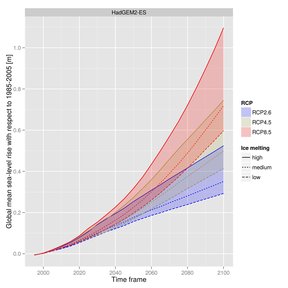Background on Coastal Themes
Sea-levels have been rising for hundreds of years, and there are concerns that the rate of sea-level rise will accelerate. This could lead to widespread flooding of low-lying areas affecting millions of people worldwide and high costs of economic damage, if adaptation does not take place.
From 1901 to 2010, global mean sea-levels rose 1.7±0.2 mm/yr, and from 1993 to 2010, rates of 2.3±0.4 mm/yr were recorded (Church et al. 2013). Sea-levels do not respond instantaneously to a rise in temperature as oceans and ice sheets take a long time to respond. Therefore there is a time-lag between atmospheric warming and sea-level rise, known as the commitment to sea-level rise. Thus, unlike other sectors and stories a +2°C global warming could produce a range of sea-level changes. Therefore, the coastal theme section of this atlas focuses on the benefits of climate mitigation in the 2080s.
Future projections of sea-level rise vary according to a range of scenarios, called Representative Concentration Pathways (RCPs). Projections from three scenarios (named RCP2.6 representing a world of climate mitigation, RCP4.5 and RCP8.5 representing a world of much higher emissions) is shown based on model projections from HadGEM2-ES (Figure global mean sea-level rise). Each scenario indicates a family of projections based on the uncertainty associated with the rate of ice melt that contributes to sea-level rise.
By the 2080s, global mean sea-levels (assuming a median rate of ice melt) are projected as 0.31 m (for a 2.0°C increase in temperatures since pre-industrial), 0.35 m (for a 3.2°C increase in temperatures since pre-industrial) and 0.57 m (for a 5.2°C increase in temperatures since pre-industrial). The commitment to sea-level rise means that even if global mean temperatures stabilise, sea-levels will keep on rising for many decades. Without stringent mitigation, sea-levels are expected to continue to rise into the 22nd century.
Socio-economic conditions affected who and what will be affected by sea-level rise. The costs and impacts presented here follow a Shared Socioeconomic Pathway 2 ’middle of the road’ scenario: There is some progress towards development goals, but there is still a dependence on fossil fuels. In the EU throughout the 21st century, population decreases, but wealth increases (O’Neill et al. 2014) as shown in Figure changes in population and gross domestic product.
The atlas shows potential costs of sea-level rise for flooding and adaptation for EU countries, and people exposed in port cities with a population of greater than 1 million people around the world.
References:
Church, J. A., Clark, P.U., Cazenave, A., Gregory, J. M. Jevrejeva, S. Levermann, A. Merrifield, M.A., Milne, G.A. Nerem, R.S. Nunn, P.D. Payne, A.J. Pfeffer, W.T. Stammer, D. and Unnikrishnan, A.S. 2013. Sea Level Change. In: Working Group I Contribution to the IPCC Fifth Assessment Report (AR5).Climate Change 2013: The Physical Science Basis.
Hinkel, J., Lincke, D., Vafeidis, A.T. Perrette, M., Nicholls, R.J., Tol, R.S.J., Marezion, B., Fettweis, X., Ionescu, C. and Levermann, A., 2014. Impact of future sea-level rise on global risk of coastal floods. Proceedings of the National Academy of Sciences of the United States of America, 111, (9), 3292-3297. doi: 10.1073/pnas.1222469111.
O’Neill, B.C., Kriegler, E., Riahi, K., Ebi, K.L., Hallegatte, S., Carter, T.R., Mathur, R., and van Vuuren, D.P. 2014. A new scenario framework for climate change research: the concept of shared socioeconomic pathways. Climatic Change, 122, (3), 387-400.



